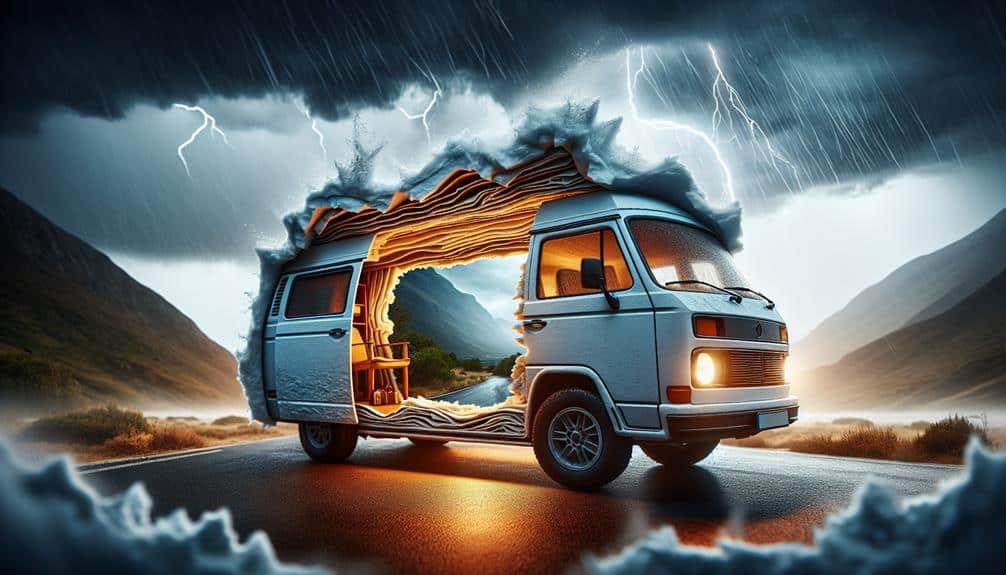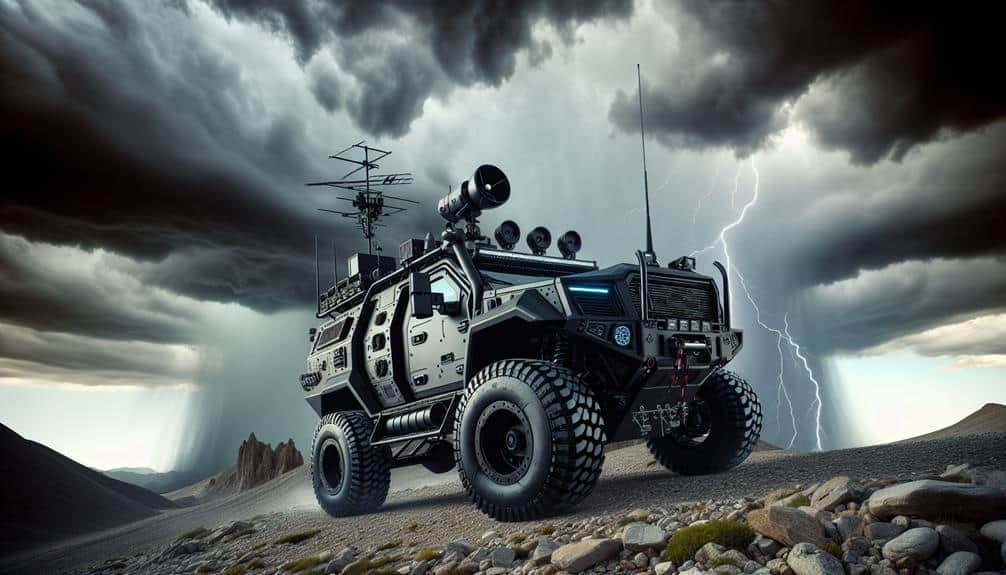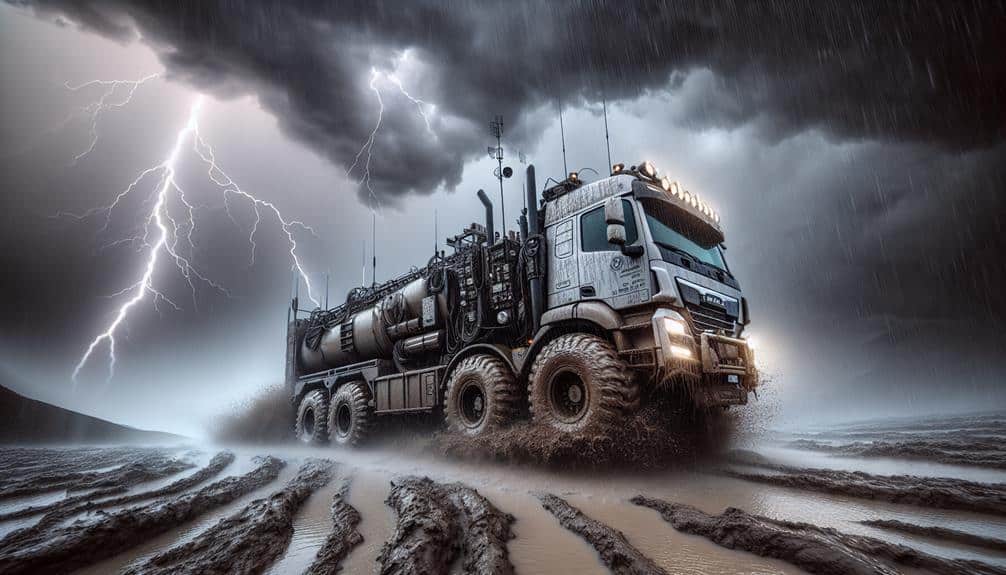For the ultimate storm chasing van conversion, we need to start by selecting a dependable van with high ground clearance and four-wheel drive, like the Mercedes Sprinter or Ford Transit. Durability is key, so let's reinforce with heavy-duty materials and upgrade the suspension. Proper insulation and weather-proofing guarantee protection against the elements. Advanced navigation and communication systems keep us connected, while smart storage solutions maximize space. Power reliability comes from solar panels and battery backups. Comfortable sleeping arrangements and good ventilation maintain our wellbeing. Don't forget emergency safety gear. There's much more to explore to perfect our mobile storm sanctuary.
Key Points
- Choose high ground clearance and four-wheel drive for off-road capability and durability.
- Install closed-cell spray foam insulation and weather stripping for superior thermal resistance and weather-proofing.
- Implement hidden compartments and heavy-duty locks for secure storage of valuable equipment.
- Equip the van with solar power, lithium-ion batteries, and a smart battery management system for reliable power.
Choose the Right Van
Selecting the ideal van for storm chasing involves evaluating factors like durability, off-road capability, and interior space for essential equipment. We need a vehicle that can handle rough terrains and unpredictable weather while providing ample room for our gear.
Off-road capabilities are paramount; we can't afford to get stuck in muddy fields or rough backroads when chasing a storm. Vans with high ground clearance and four-wheel drive are excellent choices.
Customization options are also vital. Each storm chaser has unique needs, so a van that allows us to modify the interior layout is ideal. We might need to install racks for weather instruments, secure mounts for laptops, or even a small bed for overnight expeditions.
Vans like the Mercedes Sprinter or Ford Transit offer a balance of off-road performance and customization flexibility, making them popular choices.
Additionally, we should consider the van's fuel efficiency and mechanical reliability. The last thing we want is to break down in the middle of nowhere. By selecting a van with strong off-road capabilities and extensive customization options, we're better prepared to face the challenges of storm chasing and enjoy the freedom it brings.
Focus on Durability
When we're converting vans for storm chasing, durability is paramount.
We need to select robust materials that can withstand extreme weather conditions and reinforce the van's structural integrity to guarantee safety and longevity.
Select Robust Materials
To secure our storm chasing van withstands the harshest conditions, we need to prioritize materials known for their exceptional durability and resilience. The foundation starts with waterproof flooring. By choosing high-quality, weatherproof materials, we secure that any moisture tracked in doesn't lead to mold or rot, keeping our mobile base safe and comfortable.
Next, rust-resistant framing is essential. Steel or aluminum frames treated with rust inhibitors can endure prolonged exposure to the elements. This prevents structural weakening and extends the van's lifespan, enabling us to chase storms without worrying about corrosion.
Heavy-duty hardware is another critical component. Door hinges, handles, and locks need to be robust enough to handle the constant vibrations and impacts encountered on rough terrain. Opting for industrial-grade options secures they won't fail when we need them most.
Lastly, impact-resistant walls are a must. Using materials like reinforced fiberglass or high-density polyethylene not only provides superior protection against debris but also improves the overall structural integrity of the van. This choice shields us from flying objects and harsh winds, giving us the freedom to explore even the most volatile weather conditions with confidence.
Reinforce Structural Integrity
Building on the foundation of robust materials, strengthening the van's structural integrity secures it against the relentless forces encountered during storm chasing expeditions.
We can't risk overlooking the importance of reinforcing connections and enhancing stability. Let's delve into some key techniques.
First, reinforcing the van's chassis is essential. We should incorporate cross members and gussets to fortify foundations. This approach distributes stress more evenly, reducing the risk of structural failure.
Next, let's concentrate on the body panels. Installing impact-resistant plating on vulnerable areas like the sides and undercarriage protects against debris and high winds.
Another crucial aspect is upgrading the suspension system. Heavy-duty springs and shock absorbers not only boost stability but also enhance handling in rough conditions. Attaching skid plates ensures the van's underbody remains intact when maneuvering through debris-strewn roads.
Inside the van, we can fortify interior fixtures by using secure anchoring systems. This prevents equipment from turning into dangerous projectiles during turbulent weather.
Insulate Properly

When we insulate our storm chasing vans, using durable materials is crucial for withstanding extreme conditions.
We must also seal all gaps meticulously to prevent drafts and water ingress, ensuring peak thermal efficiency.
Proper insulation not only keeps us comfortable but also protects our equipment from harsh weather.
Choose Durable Materials
For peak storm chasing performance, we should prioritize using robust, top-notch materials and secure proper insulation to withstand extreme weather conditions. A durable design guarantees our van can handle the rigors of chasing storms, from harsh winds to torrential downpours. Weather-resistant materials are essential for maintaining the van's integrity and functionality in such environments.
First, let's focus on the materials for the van's exterior. We should opt for high-gauge steel or aluminum, both of which offer excellent durability and resistance to corrosion. Reinforced fiberglass can also be a viable option, providing a strong yet lightweight alternative.
Next, we need to think about the interior. Marine-grade plywood is a fantastic choice for cabinetry and flooring due to its water resistance and strength. Pairing it with stainless steel fixtures ensures longevity.
Proper insulation is crucial to maintaining a comfortable and safe environment inside the van. Closed-cell spray foam insulation is our best bet, as it provides superior thermal resistance and acts as a barrier against moisture, preventing mold growth. Reflective insulation materials can be added to further enhance thermal efficiency, securing we stay warm in cold conditions and cool during intense heat.
Seal All Gaps
Sealing all gaps with precision is vital to secure our van remains a reliable and cozy sanctuary during intense storm chasing expeditions. By making sure that every potential entry point for wind, rain, and debris is tightly sealed, we create a strong environment capable of withstanding extreme conditions.
Let's immerse ourselves in some effective weather proofing techniques and gap sealing methods that can make all the difference.
- Use High-Quality Weather Stripping: Choose durable materials like EPDM rubber for door and window seals. This guarantees durability and resistance against harsh weather elements.
- Apply Expanding Foam: For larger gaps around structural components, expanding foam offers excellent insulation and a secure seal.
- Utilize Silicone Caulk: Ideal for smaller cracks and crevices, silicone caulk provides a flexible, waterproof barrier that adjusts to temperature fluctuations.
- Install Insulated Panels: Adding insulated panels to walls and ceilings not only seals gaps but also enhances thermal efficiency, keeping the interior comfortable.
Secure Storage Solutions
To safeguard our gear remains intact during the most turbulent chases, we need to implement robust and secure storage solutions in our storm chasing vans. Let's talk about integrating hidden compartments and reliable locking mechanisms to keep our equipment safe and organized.
First, hidden compartments can be a game-changer. By utilizing underfloor storage or built-in cabinetry, we can maximize space and keep essential gear out of sight. These compartments don't just offer a clean look; they also protect our valuable equipment from prying eyes and potential theft. For instance, storing sensitive electronics in a concealed, padded drawer can prevent damage during rough rides, making certain everything stays in top condition.
Equally important are strong locking mechanisms. We should invest in high-quality, tamper-proof locks for all storage units. Heavy-duty padlocks, combination locks, or even digital locks can provide the security we need. Bolting these units to the van's frame is another critical step to secure nothing shifts during sudden stops or sharp turns.
Lastly, let's not overlook the benefits of modular storage systems. These allow us to customize our setup based on the specific needs of each chase, providing flexibility and freedom to adapt on the fly.

Equipping our storm chasing vans with advanced navigation systems is essential for ensuring we can accurately track severe weather patterns and quickly navigate to the safest routes. With the right technology, we're not just driving—we're actively engaged in storm tracking. Installing these systems requires a blend of cutting-edge tools and insightful planning.
Let's break down the key components:
- GPS Integration: Modern GPS units with real-time updates allow us to receive accurate positioning data, vital for following dynamic storm paths.
- Weather Alert Systems: Advanced navigation systems can integrate weather alert capabilities, giving us immediate updates on severe weather conditions, ensuring we stay ahead of the storm.
- Satellite Connectivity: Reliable satellite communication keeps our navigation systems functioning even in remote areas where cellular networks may fail.
- Interactive Mapping Software: High-resolution maps with interactive features help us visualize storm trajectories, road conditions, and potential hazards.
Weather-Proofing Essentials
When it comes to weather-proofing our storm chasing vans, we need to focus on durable roofing materials, waterproof seals, and proper insulation.
Using high-quality, impact-resistant roofing will protect us from hail and debris. Additionally, ensuring all seals are watertight and adding insulation will keep the interior dry and comfortable during extreme weather conditions.
Durable Roofing Materials
Choosing the correct long-lasting roofing materials is essential to guarantee our storm chasing van can endure the most severe weather conditions. Whether it's hail, torrential rain, or high winds, our roof must stand up to the elements without fail.
When considering metal vs. rubber roofing, we need to weigh longevity vs. cost to make an informed decision.
Here's a breakdown of our top roofing material choices:
- Aluminum Roofing: Known for its incredible durability and light weight, aluminum is a go-to for long-term use. It resists corrosion and can handle extreme temperatures, though it can be pricier upfront.
- Steel Roofing: Steel offers robust protection against harsh weather and is a bit more cost-effective than aluminum. However, it's heavier and might require stronger support structures.
- EPDM Rubber Roofing: Cost-effective and easy to install, EPDM rubber is great for those on a budget. While it offers good weather resistance, it may not last as long as metal options.
- Fiberglass Roofing Panels: These provide a balance between cost and durability. They're lightweight and resistant to weather but can be less impact-resistant than metal.
Waterproof Seals & Insulation
To secure our storm chasing van remains dry and comfortable in any weather, we must prioritize high-quality waterproof seals and efficient insulation.
First, let's start with waterproofing techniques. Applying marine-grade sealant around windows, doors, and roof vents is vital. This type of sealant is designed to withstand harsh conditions, guaranteeing no water seeps into our living space.
Next, we need to explore insulation options. Closed-cell spray foam is a top choice due to its dual functions—it insulates and acts as a moisture barrier. Another viable option is reflective insulation, which helps in regulating the internal temperature, keeping us warm during cold fronts and cool during heatwaves.
Regular maintenance is key to longevity. Inspect seals regularly for cracks or wear, and reapply sealant as needed. For insulation, check for any signs of moisture accumulation, which could indicate a breach in your waterproofing.
When it comes to van customization, let's not cut corners on these essentials. Tailor our approach to fit our specific needs, whether it's adding extra layers of insulation or upgrading to more robust sealing materials.
Reinforce Windows and Doors

Ensuring our van's windows and doors are strengthened is essential for enduring the extreme conditions of storm chasing. When we're out in the field, we need robust security measures and impact resistance to protect ourselves and our equipment.
Let's delve into some practical steps to reinforce these critical components of our van.
- Apply Shatterproof Film: Apply a high-quality, shatterproof film to all windows. This film not only enhances impact resistance but also prevents glass shards from scattering if a window does break.
- Upgrade to Polycarbonate Windows: Consider replacing standard glass windows with polycarbonate versions. Polycarbonate is lightweight yet incredibly strong, offering notably higher impact resistance.
- Enhance Door Locks: Upgrade the van's door locks to heavy-duty, tamper-proof models. This adds an extra layer of security, making it harder for anyone to breach our mobile command center.
- Install Window Guards: Install metal window guards or grilles. These guards provide additional protection against flying debris and potential break-ins, ensuring that our van remains a safe haven even in the most turbulent conditions.
Power and Electrical Systems
For our storm chasing van, a reliable power and electrical system is vital to keep our equipment functioning and guarantee we can communicate effectively during important moments.
The first step is to harness solar power. Installing high-efficiency solar panels on the van's roof ensures we've a renewable energy source. These panels should be paired with a sturdy charge controller to manage the energy flow and prevent overcharging our batteries.
Next, a solid battery backup system is essential. We recommend lithium-ion batteries for their durability and capacity. They provide a dependable power reserve for our essential devices—radios, GPS, laptops, and cameras—especially when sunlight is scarce. Integrating an inverter allows us to convert the stored DC power into AC, ensuring compatibility with all our equipment.
To optimize our setup, we should invest in a smart battery management system (BMS). A BMS monitors battery health, manages charging cycles, and prevents potential issues like over-discharging. Additionally, having multiple charging options, including shore power and alternator charging, adds layers of reliability.
Ultimately, with a well-designed power and electrical system, we can chase storms with the confidence that our gear will remain operational and our communications uninterrupted, no matter where we roam.
Comfortable Sleeping Arrangements

A good night's sleep is necessary for storm chasers, and our van's sleeping arrangements need to be both comfortable and practical. We can't afford to skimp on rest; after all, the next chase could be just around the corner. Let's explore how to make our sleeping setup excellent.
First, we need cozy bedding. Quality mattresses, memory foam toppers, and soft linens are non-negotiable. They provide the comfort necessary for a rejuvenating sleep.
Next, consider an efficient layout. Space is precious in a van, so every inch must be functional.
Here's a breakdown of our ideal setup:
- Tailored Mattress: A mattress that fits the unique dimensions of our van ensures we're utilizing the space efficiently while maximizing comfort.
- Under-bed Storage: Utilizing the space beneath our bed for storage keeps our living area clutter-free and organized.
- Ventilation: Proper airflow is vital. We should install windows or vents near the sleeping area to keep it fresh and cool.
- Blackout Curtains: These help block out light and noise, creating a tranquil sleeping environment no matter where we park.
Emergency and Safety Gear
Proper emergency and safety gear is vital for storm chasers to navigate unpredictable weather conditions and stay protected on the road. We can't emphasize enough the importance of emergency preparedness in our van conversions.
Let's start with safety equipment: sturdy seat belts and airbags are just the beginning. We must also equip our vans with ruggedized communication devices, like satellite phones and two-way radios, guaranteeing we stay connected even in remote areas.
Weather monitoring is another crucial aspect. High-quality weather radar systems and barometers help us track storms in real-time, giving us valuable minutes to make informed decisions.
Don't forget a robust first aid kit, stocked with essentials like bandages, antiseptics, and pain relievers. These kits can be lifesavers in emergencies.
Survival gear is equally important. Keep a stash of non-perishable food, bottled water, and thermal blankets. A portable generator and extra fuel can also come in handy during extended outings.
Frequently Asked Questions
What Licenses or Permits Are Required for Storm Chasing?
Imagine the thrill of chasing storms! We'll need to navigate permit requirements and license regulations. Ensuring safety precautions are met and having a complete equipment checklist are essential for a successful and exhilarating storm chasing experience.
How Can I Ensure Reliable Communication While Storm Chasing?
We guarantee reliable communication while storm chasing by using satellite phones and emergency radios. Satellite phones offer coverage where cell service fails, and emergency radios keep us informed of weather updates and emergency alerts, granting us freedom.
What Are the Best Apps or Software for Tracking Storms?
Did you know that 70% of storm chasers rely on mobile apps? For the best apps and software, try RadarScope and Storm Shield. Their advanced tracking techniques and strategies keep us informed and ready for anything.
How Do I Find Storm Chasing Communities or Networks?
To find storm chasing communities, we should explore online forums and join Meetup groups. Additionally, attending local events and engaging on social media platforms will help us connect with like-minded enthusiasts and industry experts passionate about storm chasing.
What Are the Insurance Considerations for a Storm Chasing Van?
Managing insurance coverage for a storm chasing van can feel like threading a needle. We need all-encompassing policies to address liability concerns, ensuring our adventurous pursuits are protected from unpredictable risks and potential damages.


